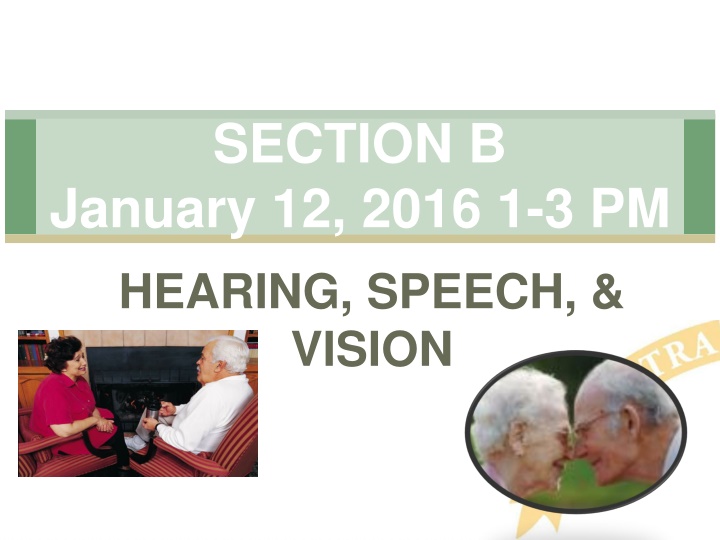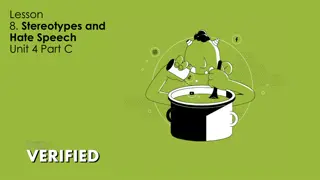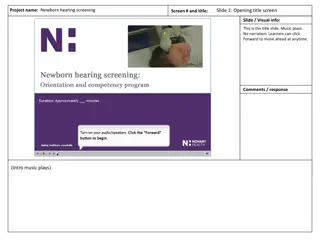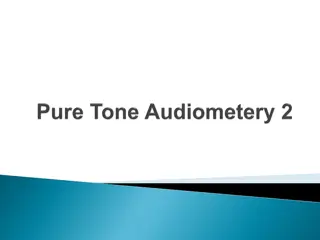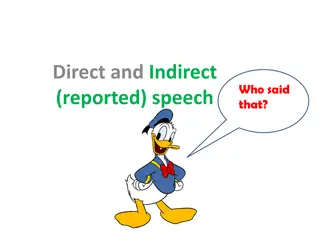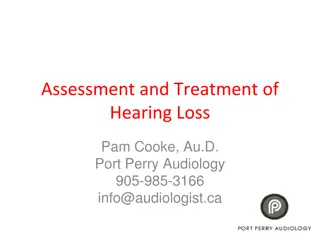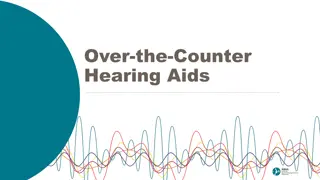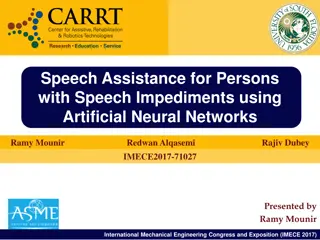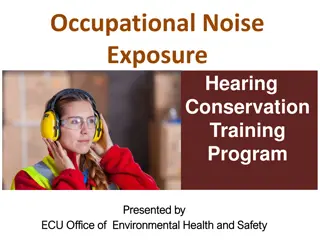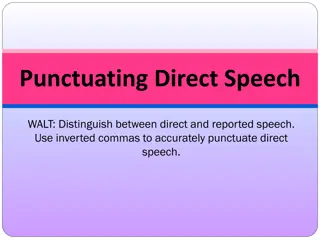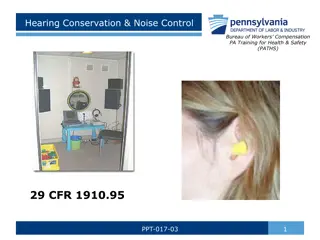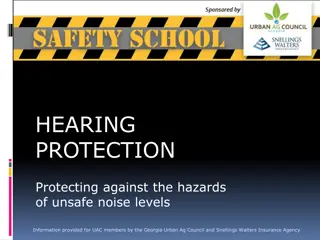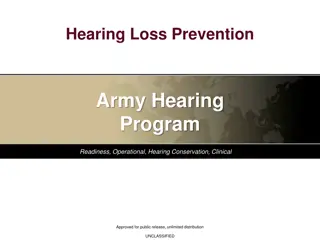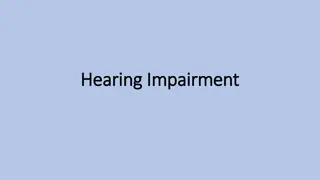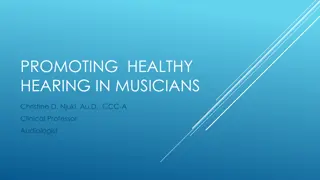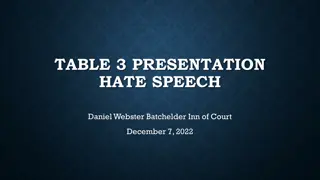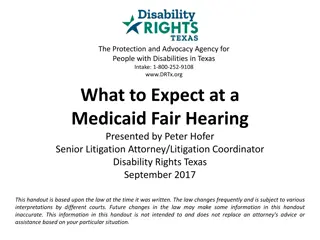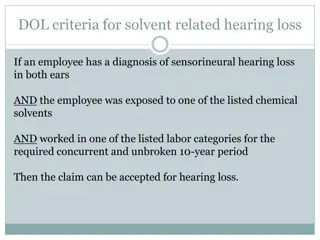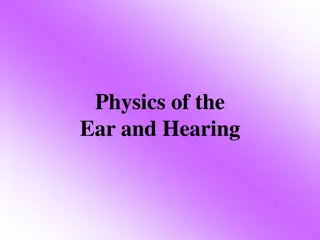Section B Assessment for Hearing, Speech, and Vision
Learn the importance of Section B assessment in preventing social isolation. Discover the steps for conducting the assessment, correct coding, and essential care plan details for hearing, speech, and vision abilities. Explore different codes for comatose, hearing levels, and hearing aid usage to ensure accurate evaluation of residents' conditions.
Download Presentation

Please find below an Image/Link to download the presentation.
The content on the website is provided AS IS for your information and personal use only. It may not be sold, licensed, or shared on other websites without obtaining consent from the author.If you encounter any issues during the download, it is possible that the publisher has removed the file from their server.
You are allowed to download the files provided on this website for personal or commercial use, subject to the condition that they are used lawfully. All files are the property of their respective owners.
The content on the website is provided AS IS for your information and personal use only. It may not be sold, licensed, or shared on other websites without obtaining consent from the author.
E N D
Presentation Transcript
SECTION B January 12, 2016 1-3 PM HEARING, SPEECH, & VISION www.dbtechno.com/images/healthy_elderly_lifespan.jpg
Objectives Understand the importance of this information in order to prevent social isolation Understand the steps for doing the assessment Understand how to code Section B correctly Understand what needs to be on the care plan
Section B Hearing, Speech, Vision Ability to hear, understand and communicate with others. Speech clarity and visual limitations or difficulties.
B0100: Comatose Comatose, Persistent Vegetative State Not end-stage Alzheimer s Disease Code 1. Yes. Physician documented DX SKIP to Section G. Functional Status
B0200: Hearing Level of hearing Always attempt resident interview Use hearing aid or appliance as normal Ask ability to hear in different situations Ask family, significant other, staff, specialists Observe resident who is cognitively impaired in various situations
B0200: Hearing Coding Code 0. Adequate. No difficulty in normal conversation, social interaction, or listening to TV. Hears all normal conversational speech and telephone conversation and announcements in group activities. Code 1. Minimal Difficulty. Difficulty in some environments, e.g., when person speaks softly or noisy setting. Hears speech at conversational levels but difficulty hearing when not in quiet listening conditions or when not in one-on- one situations. Hearing adequate after environmental adjustments made, i.e. reducing background noise by moving to quiet room or by lowering volume on television or radio.
B0200: Hearing Coding Code 2. Moderate Difficulty. Speaker has to increase volume and speak distinctly. Although hearing-deficient, compensates when speaker adjusts tonal quality and speaks distinctly; or can hear only when speaker s face clearly visible. Code 3. Highly Impaired. Absence of useful hearing for conversing. Hears only some sounds and frequently fails to respond even when speaker adjusts tonal quality, speaks distinctly, or positioned face-to-face. No comprehension of conversational speech, even when speaker makes maximum adjustments.
B0300: Hearing Aid Code 1. Yes. Did use hearing aid (or other hearing appliance) for Hearing Assessment in B0200
B0600: Speech Clarity Quality of Speech not content or appropriateness Listen to resident speak Ask staff Review clinical record
B0700: Makes Self Understood* Ability to express or communicate requests, needs, opinions, and to conduct social conversation in primary language. B0800: Ability to Understand Others Comprehension of direct person to person communication. Gestures, Verbal, Written, Sign Language, Braille, Combination
Assessment Interact with resident Use preferred language & communication devices Observe interactions with others, ability to communicate and understand Interview primary caregivers, family, SLP as appropriate
*B0700: Makes Self Understood* Code 0. Understood. Expresses requests & ideas clearly Code 1. Usually Understood. Difficulty communicating words or finishing thoughts but able if prompted or given time. May have delayed responses or may require some prompting to make self understood Code 2. Sometimes Understood. Limited ability, but able to express concrete requests of basic needs: food, drink, sleep, toilet Code 3. Rarely or Never Understood. Understanding limited to staff interpretation of highly individual, specific sounds or body language (e.g., in pain or need to toilet)
B0800: Ability to Understand Others Code 0. Understands. Clearly comprehends message(s) and demonstrates comprehension by words or actions/behaviors. Code 1. Usually Understands. Misses some part or intent of message butcomprehends most of it. May have periodic difficulties integrating information but generally demonstrates comprehension by responding in words or actions.
B0800: Ability to Understand Others Code 2. Sometimes Understands. Demonstrates frequent difficulties integrating information, and responds adequately only to simple and direct questions or instructions. When staff rephrase or simplify message(s) and/or use gestures, comprehension enhanced. Code 3. Rarely/Never Understands. Demonstrates very limited ability to understand communication. Staff have difficulty determining whether or not comprehends messages, based on verbal and nonverbal responses. Hears sounds but does not understand messages.
B1000: Vision Ask staff & resident usual vision pattern Test close vision with visual appliance in place & adequate lighting Have read aloud newspaper, start with headlines & end with smallest print If unable to read newspaper print, provide other items with larger print, e.g. flyer, large print book Aphasia or illiteracy provide numbers, or pictures that are equivalent in size to regular and large print
B1000: Vision Code 0. Adequate. Sees fine detail, including regular print in newspapers/books. Code 1. Impaired. Sees large print, but not regular print in newspapers/books. Code 2. Moderately Impaired. Limited vision and not able to see newspaper headlines but can identify objects in environment. Code 3. Highly Impaired. Ability to identify objects in environment in question, but appears to follow objects (especially people walking by). Code 4. Severely Impaired. No vision, sees only light, colors or shapes, or does not appear to follow objects with eyes.
B1200: Corrective Lenses Code 1. Yes. Used eyeglasses, corrective lenses, or other visual aids during B1000: Vision assessment Do not Code 1. Yes. If uses corrective lenses or another visual aid on regular or daily basis but did not use for B1000: Vision assessment Visual aids do not include surgical lens implants.
Care Plan Considerations Is the elder Comatose or in a Persistent Vegetative State Are hearing aides used and if so in which ear and how does the elder take care of them, i.e. take them out at night and store them where, change batteries how often, clean them If hard-of-hearing and no hearing aides used, which ear can they hear the best with, do they read lips, is it easier to write their communications, does a hearing evaluation need to be scheduled and who do they use A quiet environment is always necessary or it doesn t make a difference
Care Plan Considerations continued Unclear or absent speech can be very frustrating and can result in physical and psychosocial needs not being met resulting in depression and social isolation. Staff must know how to determine what the resident needs Inability to understand others can severely limit associating with others and inhibit their ability to follow instructions Moderate, high, or severe vision impairment can contribute to sensory deprivation, social isolation and depressed mood Do they wear glasses, if so, when. How do they care for them, where do they store them
Questions? I ll take the next few minutes to answer any questions you might have
Thank you!! Please feel free to contact me Shirley L. Boltz, RN RAI/Education Coordinator 785-296-1282 shirley.boltz@kdads.ks.gov
